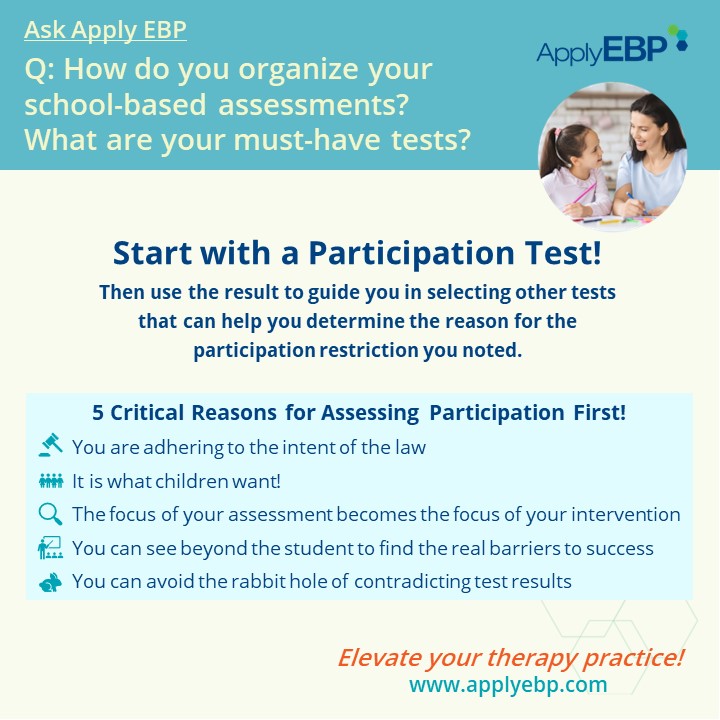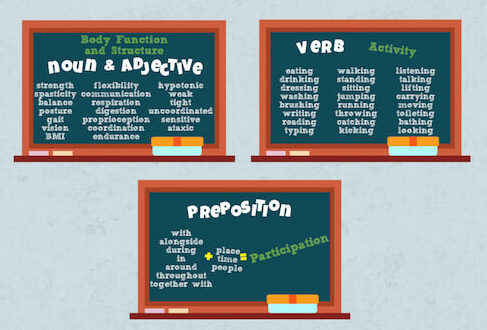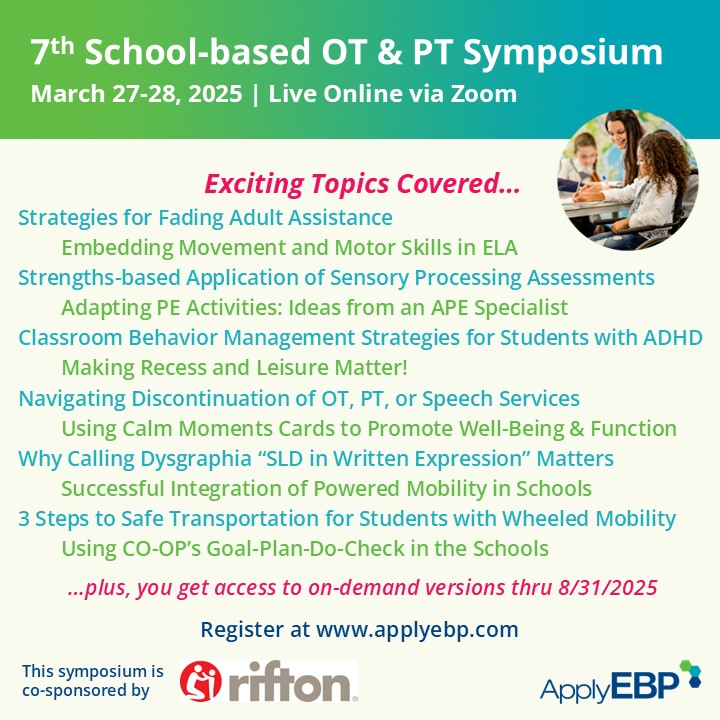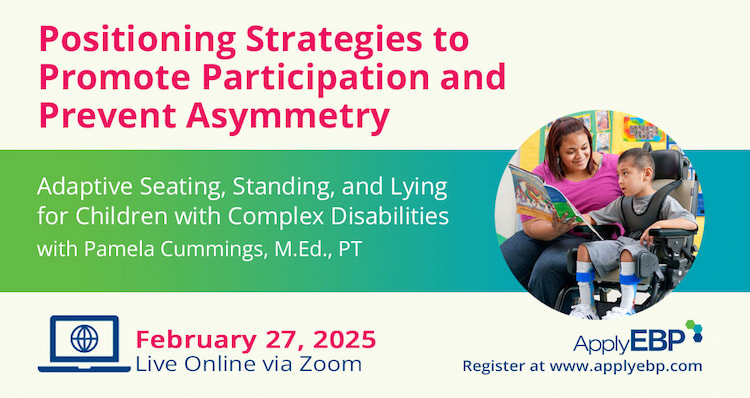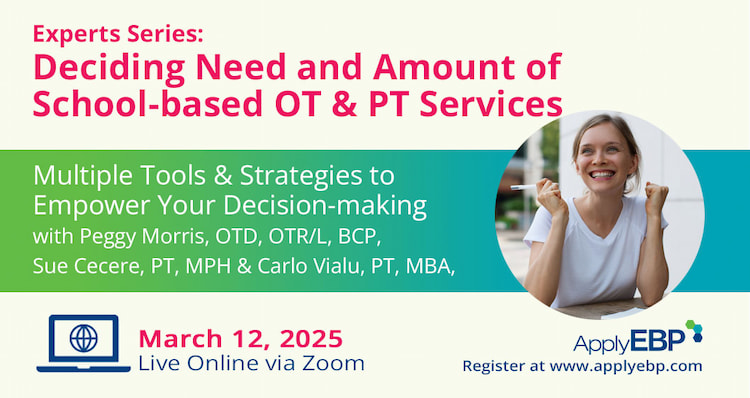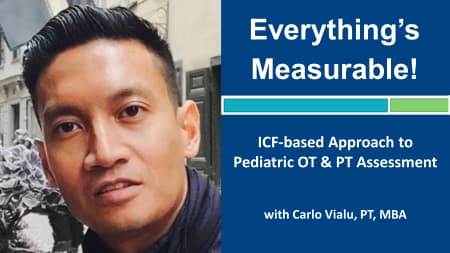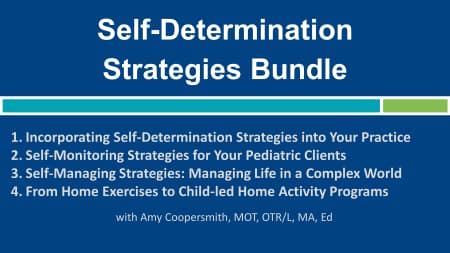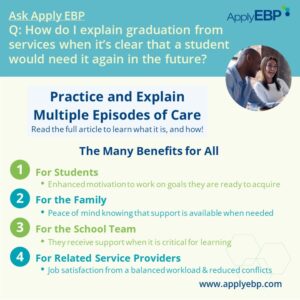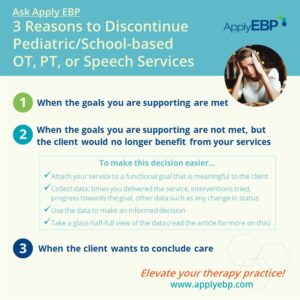Ask Apply EBP
Must-Have Test and Organizing Your School-based Assessment
This article is first in a series of articles about school-based assessments. After reading this, proceed to 3 Principles for Selecting Tests…on a limited budget.
Q: How do you organize your school-based assessments? What are your must-have tests?
The Short Answer
Must-have Test: A test for School Participation!
-
-
- This can be a standardized test, like the Part 1 of the School Function Assessment.
- Or you can do skilled observation in the real environment (aka contextual observation or ecological assessment).
- here are some of our favorite participation tests:
- Top 3 Free Participation Tests
- Ecological Assessment + how to access a free EA form
- Top 3 For-a-Fee Participation Tests (article coming soon!)
-
Organizing the Assessment: After testing school participation, use the result to narrow down what other tests you need to conduct that can help you determine the reason for the participation restriction you noted. This can be a test at the Activity or Body Function and Structure levels.
The Long Answer
There are a lot of good reasons why it is best to start testing at the participation level. To help explain my reasoning for the above, allow me to do a quick review of the International Classification of Function (ICF) terminologies here:
-
-
- Participation
- “involvement in a life situation” (ICF-CY, 2007)
- This is what the child actually does in their real-life environment.
- These are purposeful activities done with their peers, such as completing classwork in ELA, playing at recess, or eating in the lunchtable with peers during mealtime.
- This roughly corresponds to the term “occupation” in the OTPF-4.
- Activity
- “execution of a task or action by an individual” (ICF-CY, 2007)
- These would be verbs such as jumping, writing, and talking. These are not necessarily done during real-life routines nor with peers, like writing their name in the “therapy room”, or learning to use a walker in an empty hallway.
- This roughly corresponds to the term “performance skills” in the OTPF-4.
- Body Function and Structure
- Body function refers to “the physiological functions of body systems,” whereas body structures refer to “anatomical parts of the body such as organs, limbs and their components”(ICF-CY, 2007)
- These would be terms such as sensory processing, range of motion, visual perception, spasticity, coordination.
- This corresponds to the term “client factors” in the OTPF-4.
- Participation
-
This SeekFreaks infographic would help you identify terms for these 3 levels. You may also read the full article here if you feel like it.
Why Use a Top-Down Approach to Assessments?
I’m sure you’ve heard of a “top-down” approach to interventions. That is when your intervention focuses on participation or occupation first! While a “bottom-up” approach starts at the body function and structure level.
The same approaches can also be used in our assessments. What I am recommending here is the use of a “top-down” approach to assessment that starts at the participation level!
Why? Here are some critical reasons why…
Reason #1: You Are Adhering to the Intent of the Law
Let’s start with the Individuals with Disabilities Education Act (IDEA), the main reason why occupational and physical therapists in schools.
IDEA was enacted “to ensure that all children with disabilities have available to them a free appropriate public education that emphasizes special education and related services designed to meet their unique needs and prepare them for further education, employment, and independent living.” (IDEA §300.1)
Allow me to emphasize the last part: in school-based practice, we are tasked to prepare them for further education, employment, and independent living! These 3 are not body function and structure or activity. They are about participation in college (or other studies), in a career, and in the community!
Therefore, school-based therapists need to assess and intervene to help them succeed in participating in these 3 post-school outcomes. And assessing participation would be a great place to start to adhere to the task given us by IDEA.
Reason #2: It Is What Children Want!
Knowing what children wants, helps us discover what motivates them to engage in our services and in real life!
In one of my favorite studies, Vroland-Nordstrand, et al (2015), divided subjects into 2 groups. In one group, they asked the parents to identify their goals for their children (using the Canadian Occupational Performance Measure: COPM). In the other group, they asked the children to self-identify their goals (using the Perceived Efficacy and Goal Setting system: PEGS).
The authors found that parents tended to choose goals related to ADLs, such as toileting and dressing. While the children’s self-identified goals “had a broader perspective including participation in leisure and schoolwork.” You have probably witnessed the same in your practice, where your pediatric clients want to socialize and engage in tasks with their peers.
Therefore, if we assess participation first, we are already focusing on what they want and what motivates them! This is very important because of reason #3…
Reason #3: The Focus of Your Assessment Becomes the Focus of Your Intervention
Whether we like it or not, what we assess is what we eventually intervene on! We can’t help it. We are a profession of helpers, and we want to help with the challenges we identify.
For example:
-
-
- If an OT assesses visual motor (VM) and visual perceptual (VP) skills, and find that the student has deficits in these areas, they would, more often than not, intervene to improve VM and VP skills. This may be via mazes, puzzles, visual activity worksheets, or other similar activities.
- If a PT assesses balance, and find that the student has balance deficits, they would, more often than not, intervene to improve balance with activities such as balance beam, standing on one foot, or other balance activities.
-
There are a couple of issues with this. First, visual motor, visual perceptual, and balance are all in the body function and structure level of the ICF, not the participation level! And we now already know this is not what children want (Reason #2 above).
The 2nd issue with these examples, is that we now know that a “top-down” approach to intervention works better than a “bottom-up” approach (Novak and Honan, 2019), and that evidence on upstream effects of interventions from the bottom to the participation level “are often less convincing” (Novak et al, 2020).
-
-
- For example, we know that for children with handwriting challenges, the bottom-up sensorimotor interventions addressing isolated component skills, such as “visual perception, kinesthesia, in-hand manipulation, visual–motor integration, or biomechanical features of handwriting, have no effect on handwriting legibility.” (Grajo et al, 2020) What improves handwriting legibility is the practice of handwriting, including the use of cognitive strategies – a top-down approach!
-
So, if we want to provide the evidence-supported top-down approach, we need to start our assessment from the top as well! If we assess participation first, and we find that there are restrictions with the student’s participation, we cannot help but intervene at the participation level. And remember, this is what IDEA and children want us to work on!
Reason #4: You Can See Beyond the Student to Find the Real Barriers to Success
Have you ever evaluated a child who seems to do well with your testing in the “therapy room”, but whose teacher reports is unable to participate in the classroom?
Testing in the “therapy room” gives us an isolated view of an isolated skill. On the other hand, assessing participation gives us a fuller picture of what is happening with the student when they perform real-world tasks in their real environment. In essence, we see the fit between the student and their environment.
By assessing participation, we expand the focus from just the student to also looking at how their environment may be the barriers or facilitators to their participation, such as, the physical environment (e.g., classroom layout, furniture), social environment (e.g., attitudes of adults and peers), instruction (e.g., delivery, type), and others.
And many times, we would find that these environmental barriers may be more malleable to change than impairments in the student’s body function and structure. The environmental barriers may be easier to address to allow instant change in their participation (such as by changing the classroom layout, switching furniture, building inclusive attitudes in adults and peers, using visuals to deliver instructions).
Reason #5: You Can Avoid the Rabbit Hole of Contradicting Test Results
Raise your hand if you have at some point in your career found yourself trying to explain away and get out of this rabbit hole of contradiction:
-
-
- You tested the body function and structure and found that the child scored below average (e.g., results of the VMI, TVPS, SPM-2, BOT-2 or other tests).
- But…the student is functioning well in the classroom.
- You want to recommend that the child does not need your services because they are functioning well.
- But the family and the teacher are concerned about the below-average scores!
-
I’ve got my hand raised!
Raise your hand if this happens quite a few times.
What I described above is a “bottom-up approach” to assessment. And as you can see, it can get you into this rabbit hole of contradiction. You can avoid having the need to dig yourself out of this hole by assessing participation first (top-down approach)! How?
-
-
- Assessing participation first helps you narrow down what other assessment tools to use at the activity and body function and structure levels. Select only tests that can help you explain the participation restrictions you have discovered.
- For example, if you noted that they are having a problem participating in mealtime and it seems the problem is stemming from a motor reason (and not behavior, cognitive or sensory reasons), then you should carefully consider tests that can help you dig deeper into that motor reason that may be contributing to their difficulties in mealtime.
- This also means that if you find no restrictions in their participation, there should be no need for you to utilize tests at the lower levels (such as the VMI, SPM-2, TVPS, BOT-2, etc.). It would not matter what they score on those tests because they are participating well!
- Assessing participation first helps you narrow down what other assessment tools to use at the activity and body function and structure levels. Select only tests that can help you explain the participation restrictions you have discovered.
-
On a philosophical note: we all have strengths and weaknesses. We utilize our strengths to succeed, despite any weaknesses we may or may not know we have. A weakness in one or a few areas of our body function and structure does not necessarily mean that we cannot participate meaningfully in real life occupations. So it is with our pediatric clients!
So, here are the takeaways for organizing assessments!
-
-
- Start by assessing participation first.
- Use the results of that test to guide you in selecting other tests at the activity and body and function structure levels that can help you determine the reason for the participation restriction you noted.
- And know that sometimes, you do not need to go further than the participation level, especially when you find that the child is participating without restrictions.
-
If you want to know more about what tests you can use for assessing participation, here are some options:
-
-
- Read my free article “Why I Still Like the SFA! SeekFreaks’ Fixes to 4 Big Complaints about the Test”
- Take the 1.5-hour on-demand webinar “Assessing School Participation”
-
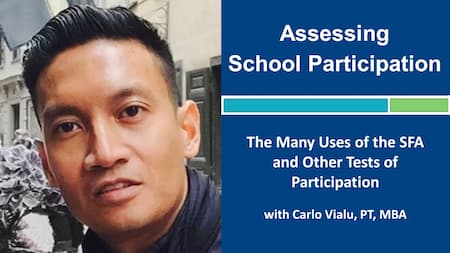
-
-
- Or take the 12-hour course: Everything’s Measurable!
-
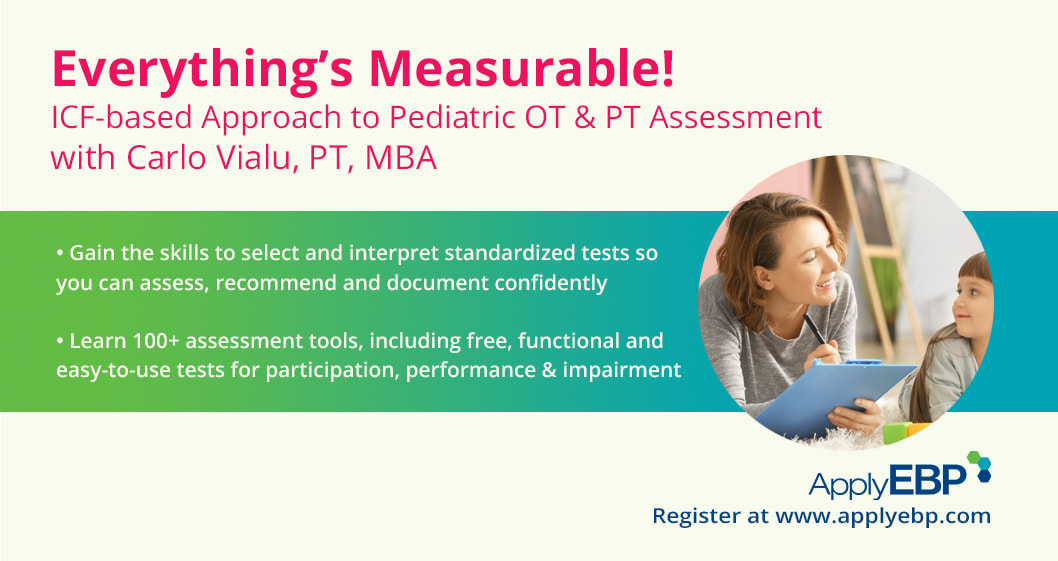
Also, check out…
References:
-
-
- Grajo, L. C., Candler, C., & Sarafian, A. (2020). Interventions within the scope of occupational therapy to improve children’s academic participation: a systematic review. The American Journal of Occupational Therapy, 74(2), 7402180030p1-7402180030p32.
- Novak, I., & Honan, I. (2019). Effectiveness of paediatric occupational therapy for children with disabilities: A systematic review. Australian occupational therapy journal, 66(3), 258-273.
- Novak, I., Morgan, C., Fahey, M., Finch-Edmondson, M., Galea, C., Hines, A., … & Badawi, N. (2020). State of the evidence traffic lights 2019: systematic review of interventions for preventing and treating children with cerebral palsy. Current neurology and neuroscience reports, 20(2), 1-21.
- Vroland‐Nordstrand, K., Eliasson, A. C., Jacobsson, H., Johansson, U., & Krumlinde‐Sundholm, L. (2016). Can children identify and achieve goals for intervention? A randomized trial comparing two goal‐setting approaches. Developmental Medicine & Child Neurology, 58(6), 589-596.
-
Find More Answers to Your Questions in Our...
Featured School
Symposium
Featured Live
Workshop
Featured On-Demand
Webinar
Everything's Measurable! OT & PT Tests
Featured Webinar
Bundle
Self-Determination Strategies Bundle
Have a question?
Submit here…
*Clicking submit will send your question directly to our email inbox. Your name and email will let us know that your submission is real (not spam). We will not include these in our posts, unless you tell us to include your name. Please read our privacy policy here.
All infographics and videos on www.applyebp.com are intellectual properties of Apply EBP, LLC
You may use the infographics and videos for free for any non-commercial, educational purposes. Please cite the source as “Apply EBP, LLC” and a link to the source article. If you plan to use any infographic or video for commercial purposes (i.e., for profit), please email Carlo@applyebp.com to obtain a written permission. Permission can be granted on a case-by-case basis.

